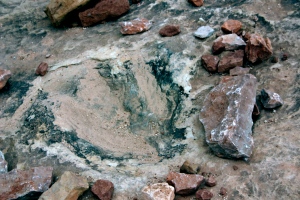Moab, UT is a cool town. It just has that vibe that tells you it’s alive and fun. Most of my stay there was somewhat dampened by the fast that I was not feeling that well.
Our campground there was a great set up as well. The four days that we stayed there were the only days that we got to take a shower. We also got to do all of our laundry while there. These were both really good things.
One day we hiked up to the megatrack site where we found dinosaur footprints. It was about a two-mile hike up. It was a beautiful hike up.
The green that you see in these formations is copper.
Here are the tracks.
More tracks
Here is a series of tracks.
This particular track is thought to be a Megalosaurus. The reason paleontologist think that is because its middle “toe” is curved.
Once we made it to the area with the series of footprints, we measured the length of the footprint along with the length of the stride.
From that data, we used a formula to find how fast these particular dinosaurs run. We then measured each person’s foot length and stride then timed how fast we could go in a given distance. From this we could make a comparison between how fast dinosaurs could run compared to how fast we can run. Let’s just say it’s a good thing that dinosaurs aren’t around anymore because if they decided that I was a juicy morsel to eat, I would be no match. Those bad boys were fast.
Here is a photo of our group doing calculations. It was actually cold that day. As you can see, we were wearing coats.
This is not the Gordon’s Fisherman. This is just Adam checking his email.
Next we learned how to take strike and dip measurements with our compasses. Here is Jackie showing Matt how to do this.
Not only does Jackie know her stuff, her love for what she does is absolutely infectious. She really makes you love what she loves and that is geology.
The last thing we did that day was to climb up a hill to get an overview of the site. Do you see the long rows of rock formations? These are called fins. This is how arches are formed. If there are no fins, then there will be no arches.
 Arches National Park lies atop an underground salt be that is responsible for the arches and sandstone fins located there. The major formations seen there today are formed from the salmon-colored Entrada sandstone and the buff-colored Navajo sandstone.
Arches National Park lies atop an underground salt be that is responsible for the arches and sandstone fins located there. The major formations seen there today are formed from the salmon-colored Entrada sandstone and the buff-colored Navajo sandstone.













